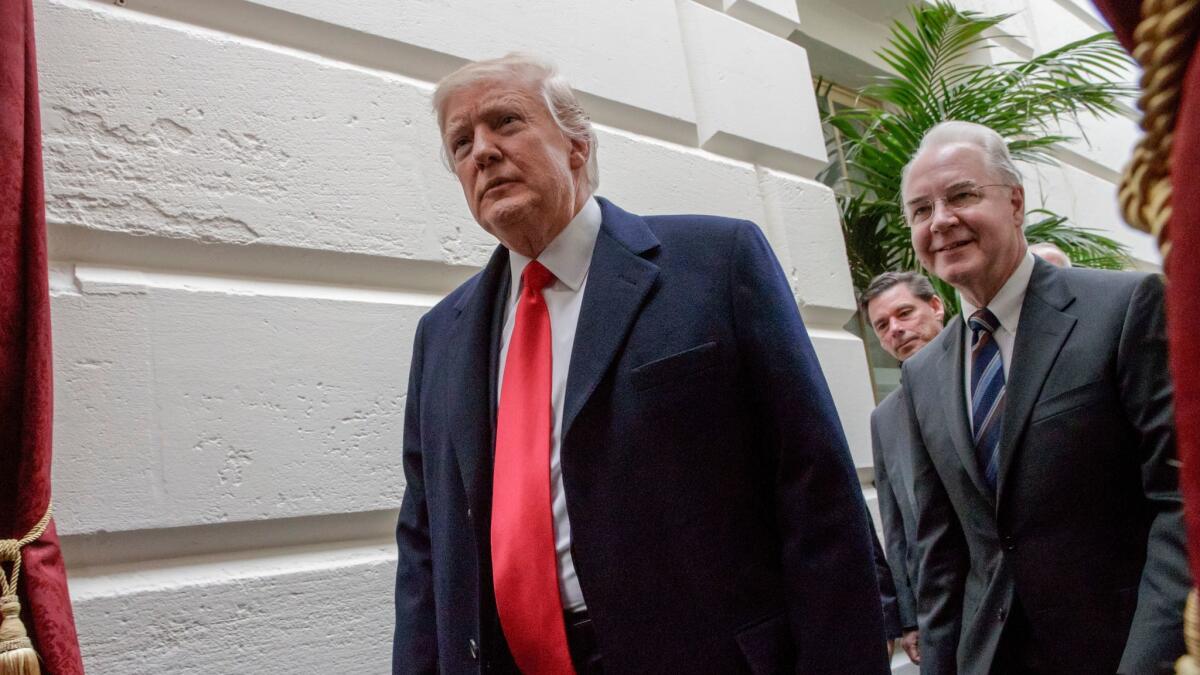Column: Trump’s sabotage of Obamacare has just claimed 10,000 new victims

A major shoe dropped in the battle to preserve the Affordable Care Act on Tuesday, as Anthem, the nation’s second-largest health insurer, announced it is withdrawing entirely from the individual market in Ohio.
The move will leave 18 counties without an insurer in the ACA exchanges, leaving an estimated 10,500 Anthem customers high and dry — most of them in Appalachia, among the poorest parts of the state.
Anthem said in its announcement that the principal causes of its withdrawal are “the shrinking individual market as well as continual changes in federal operations, rules and guidance.”
[The] increasing lack of overall predictability simply does not provide a sustainable path forward to provide affordable plan choices for consumers.
— Anthem explains its withdrawal from Ohio
That’s a reference to the uncertainty surrounding President Trump’s vagueness about whether he will approve subsidies for deductibles and co-pays for the poorest Obamacare enrollees and whether his administration will continue enforcing the ACA’s individual mandate in 2018.
The “increasing lack of overall predictability,” Anthem said, “simply does not provide a sustainable path forward to provide affordable plan choices for consumers.”
Anthem’s withdrawal from Ohio follows high-profile abandonments of the Obamacare exchanges by major insurers UnitedHealth, Aetna and Humana, all of which cited multimillion-dollar losses in that market when they first announced they were considering pullbacks last year.
United, however, had never been a major participant in the individual market. And according to a federal judge who rejected an Aetna-Humana merger earlier this year, Aetna’s complaint about financial losses was partially a smokescreen to conceal that it was using the threat of withdrawal to pressure the Obama administration into allowing the merger to go through. Instead, the administration sued to block the deal.
Anthem’s action in Ohio is its first withdrawal from a state thus far, but bodes ill for customers in the 13 other states where it offers ACA plans, including California.
More important, it underscores the costs that insurance customers across the country will face unless Trump and the Republican majorities in Congress take action to shore up the individual market. Instead, they’ve been undermining it at every turn.
The costs of their action — or inaction — are being documented by insurance executives and regulators in an increasing number of states.
The most detailed look at the impact of government policies under Trump and the Republican Congress comes from Covered California, the state’s ACA exchange.
Under normal conditions, Covered California says, it would expect a premium increase of about 9% for next year. That includes 7% based on increased medical costs and a one-time 2% increase reflecting the reimposition of a health insurer premium tax that was suspended through this year. That’s close to the average 7% annual increase for Covered California plans since the exchange’s launch in 2014.
In that case, Covered California enrollment would remain stable at about 2.4 million people, about half of whom receive premium subsidies.
If the cost-sharing reduction payments are eliminated and the administration stops enforcing the individual mandate requiring everyone to carry insurance, however, enrollment would fall and prices would soar.
Enrollment would drop to about 2.07 million. The average premium increase would be 42%, not 9%. More than half of the additional premium would result from non-enforcement of the mandate, which would leave older and sicker enrollees in the insurance pool while allowing younger and healthier residents to bail out without penalty. The rest of the increase would come from the loss of cost-sharing reduction payments because insurers would be bound to continue offering low-income residents lower deductions and co-pays, but wouldn’t receive money from the government to make up the difference.
“The premium increase caused by these policy changes would result in a worse risk mix and higher premiums,” Covered California says, “as healthier, lower-risk consumers are ‘priced out’ of coverage.” The burden would fall hardest on buyers with household income above 400% of the federal poverty line, or $98,400 for a family of four. The shock would be cushioned for those below that level, as premium subsidies rise in tandem with premiums.
California’s exchange would remain relatively healthy, however, compared to some other states. That’s because California has been an aggressive supporter of the ACA, keeping enrollment high through marketing and outreach and managing health plan offerings to maintain competition and keep costs low. Eleven insurance companies compete statewide, though not all offer plans in every county. Still, 92% of consumers in the state can choose from at least three insurers, and none has fewer than two choices.
California’s estimate of premium increases because of government policies is matched by those in other states where premium applications have started to flow from insurers.
Blue Cross Blue Shield of North Carolina, for instance, on May 25 announced a 22.8% premium increase for 2018. But most of that hike was caused by fears that the cost-sharing reduction payments would not be made next year. If the federal funding were secure, the company said, it would have sought an average increase of just 8.8%.
If the individual mandate is repealed and cost-sharing reduction payments are not made, however, “insurers estimate they would seek an increase of 36.3%.”
Although the ACA’s critics assert that such increases are the residue of the original law, indications contradict that. Both the Congressional Budget Office and Standard & Poor’s expect the 2018 markets to be stable under existing policies. The instability reflected in double-digit premium increases is entirely the result of Trump’s failure to ensure that the cost-sharing reductions are paid and the GOP’s inconclusive efforts at repeal. Under those conditions, more shocks in more states are undoubtedly coming.
Keep up to date with Michael Hiltzik. Follow @hiltzikm on Twitter, see his Facebook page, or email [email protected].
Return to Michael Hiltzik’s blog.
More to Read
Inside the business of entertainment
The Wide Shot brings you news, analysis and insights on everything from streaming wars to production — and what it all means for the future.
You may occasionally receive promotional content from the Los Angeles Times.











